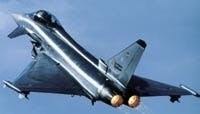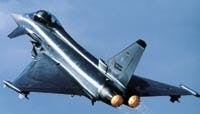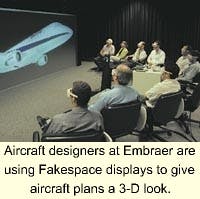Computer peripherals
Primagraphics helps BAE Systems with Eurofighter test and recording system
Aircraft designers at BAE Systems in Warton, England, needed equipment to record real-time video to help them evaluate the Eurofighter Typhoon jet fighter aircraft during flight tests.
The VME-based hardware and software from Primagraphics in Litlington, England, that captures, records, and displays video in real time met BAE's needs.
BAE Systems is one of Europe's largest aerospace and defense companies. Its aerospace engineers will use Primagraphics equipment to capture the multiplexed video stream, which they receive via a microwave link from the Eurofighter, and then time stamp each frame, Primagraphics officials say.
The Primagraphics equipment then processes the de-multiplexed images for display on a standard workstation. This way, BAE ground staff can analyze different aspects of the Eurofighter's sortie as it progresses.
"Quite simply Primagraphics won this contract because they were the only company that was able to provide a solution which met our technical specification in full and came within budget," explains Alan Wilkie, project engineer at BAE Systems.
Primagraphics designed BAE's video-processing system to delay the video sequences by as long as five seconds to enable BAE experts to synchronize them with data relayed from other systems aboard the Eurofighter.
The Primagraphics system also helps operators to record specific maneuvers using a 200-second store provided on the system. This enables the operators to replay video sequences to verify that the Eurofighter avionics are working correctly.
For more information contact Primagraphics by phone at 011 44 (0) 1763 852222, by fax at 011 44 1763 853334, by post at New Cambridge House, Litlington, Nr. Royston, Herts. SG8 0SS, England, or on the World Wide Web at http://www.primagraphics.co.uk/. Also, use the World Wide Web to contact BAE Systems at http://www.bae.co.uk/. — J.K.
Integrated circuits
TRW starts production on rad-hard RH32S computer for Astrolink
Engineers at the TRW Inc. Systems and Information Technology division in Redondo Beach, Calif., finished developing the RH32S radiation-hardened computer-on-a-chip for a satellite data communications system.
The RH32S is central to controlling the advanced digital processors on-board the satellite global broadband telecommunications system of Astrolink International LLC in Bethesda, Md.
TRW engineers are building the communications payloads for Astrolink, which is scheduled to begin providing international broadband access in 2003. The first five RH32S chips are installed in development stations where experts are testing them and using them to develop Astrolink applications software, TRW officials say.
TRW chip designers have begun full-scale production on the chips that will go into the Astrolink payloads.
"The TRW RH32S is the highest-performance radiation-hardened computer in the world today," claims Paul Borzcik, TRW's Astrolink program manager. "This chip's radiation hardness and its circuit design combine to provide an extremely fault-tolerant computer that ensures the levels of reliability commercial telecommunications customers have come to expect."
The RH32S replaces a unit that formerly required five chips packaged in a multichip module housing, a change that reduces weight by 90 percent and power by 80 percent, TRW officials say.
Each Astrolink payload employs 16 RH32Ss. The silicon chips are complex digital processors, containing more than 5 million transistors each, and fabricated in the complementary metal oxide semiconductor, or CMOS, process.
The 16 RH32Ss in each payload operate as building blocks of a distributed controller architecture. RH32 functions include allocation and control of payload resources, such as the modems and ATM switch queues, security and fault management, and handling of the messages sent by Astrolink's network control centers.
The Astrolink RH32S runs proprietary application software developed with commercial off-the-shelf (COTS) software tools and runs on a COTS operating system, company officials say. — J.K.
For more information contact TRW by phone at 310-764-3000, by fax at 310-812-4101, by post at R2-1028, One Space Park, Redondo Beach, Calif. 90278, or on the World Wide Web at http://www.trw.com/. Also contact Astrolink by phone at 301-581-4000, by post at 6701 Democracy Blvd., Suite 1000, Bethesda, Md. 20817, or on the World Wide Web at http://www.astrolink.com/welcome.html.
Board products
Sky provides Merlin computer for Army missile simulation
Engineers from Simulation Technologies Inc., with headquarters in Dayton, Ohio, needed computers for real-time modeling and simulation for several guided missile programs. The Merlin computer system from Sky Computers Inc. of Chelmsford, Mass., met their needs.
The experts from Simulation Technologies are using Sky's Merlin computers to support missile programs at the U.S. Army Aviation and Missile Command (AMCOM) Advanced Simulation Center (ASC) on Redstone Arsenal in Huntsville, Ala.
AMCOM's simulations support hardware-in-the-loop testing of the radio frequency (RF) seeker from a smart submunition missile program. Sky officials say they expect Simulation Technologies eventually to integrate Sky Merlin systems into other ground-attack and air-defense missile test programs.
Simulation Technologies engineers have used an eight-processor Merlin system for early program development since November 1999.
"Our requirement was to upgrade our existing i860-based system to achieve real time processing in a new dual-mode millimeter wave and infrared missile simulation," says Richard Olson Jr., chief scientist, at Simulation Technologies.
"The new simulation called for vector math processing performance at least 20 times greater than that needed in any previous simulation performed at the ASC," Olson explains. "After reviewing the options available in the market it was clear that we needed the advanced capabilities of a PowerPC AltiVec-based multiprocessor to achieve these metrics. Sky was the clear choice of suppliers because it was the only vendor who could deliver the performance we required when we needed it."
Army AMCOM technicians use hardware-in-the-loop missile seeker simulations as inexpensive alternatives to flight-testing. The millimeter-wave simulations provide real-time computer control of RF signature generation variables including time delay, range extent, Doppler bandwidth, polarization, and angle-of-arrival.
The simulation systems test millimeter-wave missile seekers tracking airborne or ground targets. These seekers use pulsed, variable-frequency transmit waveforms and short radar measurement cycles.
Simulation Technologies designers say the AltiVec-based 24-processor Merlin system gives them a thousand-fold increase in performance over the first system they used in 1979. — J.K.
For more information contact Sky Computers by phone at 978-250-1920, by fax at 978-250-0036, by post at 27 Industrial Ave., Chelmsford, Mass. 01824, by e-mail at [email protected], or on the World Wide Web at http://www.sky.com/.
Software
MUSE software tool helps Navy get the most out of practice data
Experts from MUSE Technologies Inc. in Albuquerque, N.M., are claiming a significant technological breakthrough in helping U.S. Navy leaders recreate and analyze ship, submarine, and aircraft movements during seaborne drills.
MUSE, whose engineers develop visualization and collaboration software, finished the first part of a Navy project where they are using 3D visualization technology to help Naval decision-makers gain more understanding of complex exercise data.
The six-month project was to enhance the Navy's Surface Warfare Development Group's (SWDG) analysis of anti-submarine warfare and mine warfare exercises. Company experts used a custom Windows NT-based application they wrote with the MUSE Software Development Environment 2000 to reconstruct and view exercise data in 3D.
The custom MUSE 2000-based application enables users to view the naval exercises from any perspective and to stop, advance, or reverse time.
MUSE officials say Navy officers and analysts use this capability to a gain deep understanding of tactical encounters and scrutinize details they might otherwise overlook.
One of the shortcomings with typical exercises has been the discrepancy that sometimes exists between what the ship commanders think takes place during the exercises and what subsequent review of the data suggests, explains Cmdr. Ron Adamo, SWDG director for undersea warfare.
"With MUSE, for the first time we are able to accurately see what actually takes place during an exercise even though some of the information has been available for more than 30 years," adds Patrick Jackson, SWDG's deputy director for undersea warfare. "A specific event can be isolated and viewed in the correct time-space relationship. Anomalies can be easily detected and the 'big picture' comes into focus very quickly. We expect to exponentially increase our understanding of what goes on during an exercise."
The Navy's new application brings wide range of diverse datasets — such as underwater landscape data, as well as data from submarines, ships, helicopters, aircraft, and sonobuoys — together in one software program for the first time.
"By moving to a MUSE-based application, naval analysts no longer will make a database query, and then ponder over volumes of spreadsheets. Now our analysts will be able to freely explore and experience the data and immediately gain new tactical insight from the information," Adamo says. — J.K.
For more information contact MUSE Technologies by phone at 505-843-6873, by fax at 505-766-9123, by post at 1601 Randolph Road Southeast, Suite 210, Albuquerque, N.M. 87106, by e-mail at [email protected], or on the World Wide Web at http://www.musetech.com/.
Communications equipment
Army chooses Rockwell Collins HF Messenger for Tactical Internet
Experts at the U.S. Army Communications-Electronics Command (CECOM) at Fort Monmouth, N.J., needed software to help them create a high frequency (HF) gateway for their combat-ready Tactical Internet.
The HF Messenger off-the-shelf software from Rockwell Collins in Cedar Rapids, Iowa, met their needs.
The Army's Tactical Internet, which is part of the larger 21st Century Warfighter Initiative, communicates situational, logistics, and command and control data across and between battlefields.
HF Messenger will provide airborne helicopter-to-ground data communications with ranges of more than 40 miles, Rockwell Collins officials say. The tool also will provide cross-range communications for ground-to-ground operations.
When systems integrators add HF messenger to existing HF radio infrastructures, the tool can provide secure, encrypted data communications in Joint Variable Message Format (JVMF) at rates as fast as 19.2 kilobits per second, company officials say. — J.K.
For more information contact Rockwell Collins by phone at 319-295-5100, by fax at 319-295-5111, by post at 350 Collins Road Northeast, Cedar Rapids, Iowa 52498, or on the World Wide Web at http://www.rockwell.collins.com/.
Displays
Embraer chooses Fakespace WorkWall to help with aircraft design
Engineers from Fakespace Systems Inc. of Kitchener, Ontario, installed an immersive WorkWall for Embraer, a regional jet manufacturer in Sao Jose dos Campos, Brazil, company officials announced May 31.
Embraer (Empresa Brasileira de Aeronautica S.A.) designers use the Fakespace 7.5-by-20-foot stereoscopic wall display for design reviews and marketing presentations in their new visualization center, which they built to aid in the design and development of the new ERJ170/ERJ190 family of commercial aircraft, Fakespace officials say.
The WorkWall is a flat screen, rear-projection display system that supports interactive viewing of large-scale computer-generated visualizations, simulations, and prototypes. The WorkWall enables designers to view complex assemblies in precise detail
"We have found that virtual prototyping and large-scale visualization significantly reduce time-to-market for new aircraft," said Hugo Resende, Technology Development Manager at Embraer. "We selected the WorkWall from Fakespace Systems following a four month pilot project using a single projector version of the display. In addition to proving its value for product design and engineering, the WorkWall added tremendous impact to customer presentations."
Embraer is using the WorkWall as part of a program to speed time-to-market and reduce design rework, concurrent with an expansion of product lines and monthly manufacturing capacity.
Previously, Embraer relied on standard workstation monitors and costly physical mock-ups to communicate and test design concepts, Fakespace officials say. — J.K.
For more information contact Fakespace on the World Wide Web at http://www.fakespacesystems.com.






